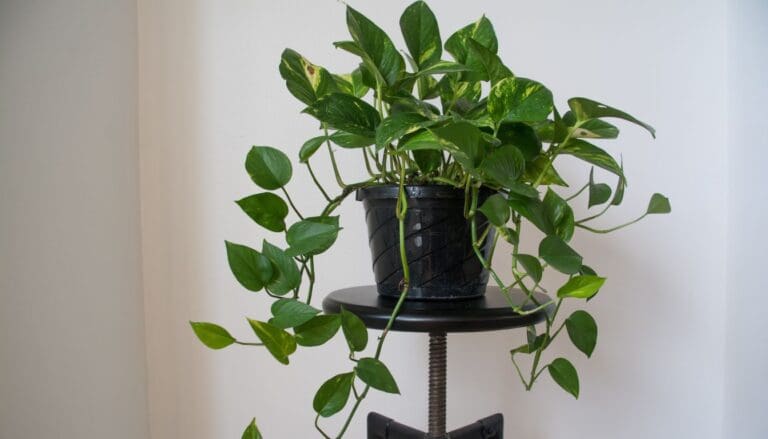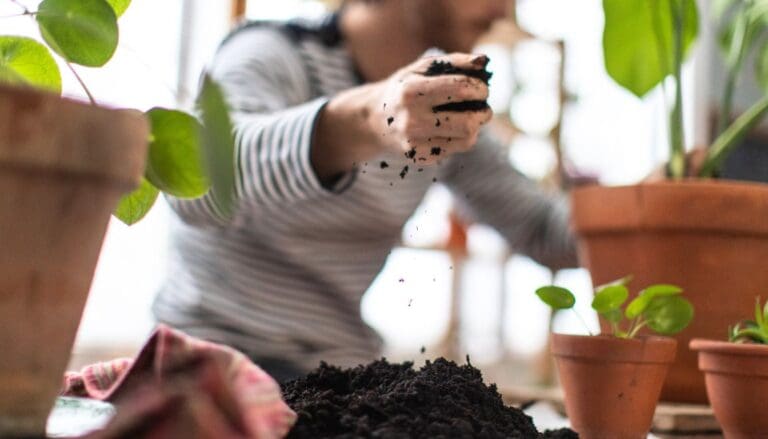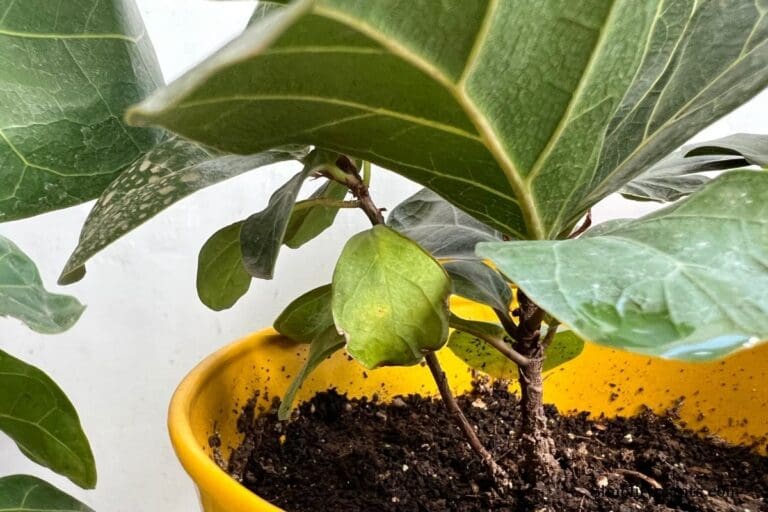Why Is My String Of Pearls Turning Yellow? (Causes+How To Fix)
The strings of pearls are beautiful hanging succulents that can add spark to your living space with their green pearl-like leaves. However, if those leaves start turning yellow, then it means that your string of pearls is having some trouble. But why is your string of pearls turning yellow? Let’s find out!
Exposure to intense sunlight, overwatering, and pest infestation are primary causes of yellow leaves in your string of pearls. Move your string of pearls to a spot where it gets filtered sunlight, adjust the watering regime, and spray some neem oil to get rid of pest infestation.
Once the leaves of the string of pearls turn yellow, you might need to get rid of them by pruning them, but you need to fix the problem so that the rest of the leaves don’t turn yellow.
We will discuss the problems in detail and find out how to fix the yellow leaves problem in your string of pearls.

Please note: Simplify Plants is reader-supported. Some links in the post are affiliate links and I get a commission from purchases made through links in the post.
Why does my string of pearls have yellow leaves?
Several problems can cause the leaves of your string of pearls to turn yellow. If you notice yellow leaves, you should not avoid the sign and find the underlying problem.
Exposure to direct sunlight
The string of pearls requires six to eight hours of indirect sunlight to remain healthy and grow fast. However, placing them under direct sunlight might not be a good idea.
Too much direct light can burn the plant and you will notice that the leaves or pearls are getting scorched and turning yellow.
Keeping the string of pearls under intense sunlight for a long period can make the plant lose all the moisture and become dehydrated.
If you have placed the string of pearls near a window and the window gets direct sunlight, you should move the plant a few feet away from the window.
You can also use blinds or curtains to prevent the direct light from hitting your string of pearls. The best idea is to find a window that gets enough indirect light throughout the day.
Overwatering

Overwatering is a common problem in all plants, but it can be life-threatening for the string of pearls.
Many beginners make the mistake that they water their string of pearls like the other tropical plants they own. But the water requirement of these succulents differs from other plants.
If you don’t understand the water requirements of your string of pearls, you might end up overwatering the plant that will keep the soil wet for too long, and the roots will get affected, and the whole plant will suffer.
If you notice yellow leaves on your string of pearls, you might want to check the root system and the soil to see if the plant is overwatered.
If you are not aware of how much water your string of pearls needs, you should start by giving little water and increasing as per the plant’s reaction.
Poor drainage system
Overwatering can take place if the string of pearls has a poor drainage system. A poor drainage system can cause the same situation as overwatering, even when you are giving it adequate water.
When we are talking about a proper drainage system, we mean using the correct soil and a pot with adequate drainage holes.
If you are not using well-draining soil, it will retain excess water and moisture that the plant doesn’t need. If you use the wrong soil mix, it will not allow air to flow between the roots and cause root rot.
A pot that doesn’t let the excess water drain out after you water the plant adds to the poor drainage system.
You should use well-draining soil that lets air flow between the roots so that the roots remain healthy. You can use cactus or succulent mix for your string of pearls.
While choosing a pot, check if it has proper drainage holes to let the excess water drain out of the system.
Over-fertilization

Plants require fertilizers as they provide nutrients to the plant that help in their growth. But adding too much fertilizer can have adverse effects on your plant.
The string of pearls can grow even without fertilizers, but you might see that the growth is prolonged. Adding some fertilizer can help boost the growth of the plant.
It would help if you avoid over-fertilizing the string of pearls as these succulents are light feeders, and adding a little fertilizer can go a long way for them.
If you over-fertilize these plants, it will burn the roots and turn the leaves yellow. Over-fertilization has salt buildup that absorbs all the moisture away from the soil, and the plant cannot get sufficient water and nutrition from the soil.
You should also make sure that you are using the right kind of fertilizer. Using the wrong fertilizer can also burn the leaves and make them yellow.
You can use a diluted liquid fertilizer once or twice during the growing season for your string of pearls. You should avoid fertilizing during the dormant period.
Pest infestation
Many pests might infest your string of pearls under unfavorable conditions. These pests suck all the nutrition out of the plant and make it weak.
Pest infestation causes issues like yellowing and browning of leaves.
Some common pests that might attack your string of pearls are:
- Aphids
- Spider mites
- Mealybugs
- Scales
- Ants
Check the plant thoroughly if you think pests infest your plant and take action immediately.
You need to isolate the plant so that other plants don’t get infected and use natural remedies such as spray diluted neem oil.
Root rot

Root rot is a severe condition in plants that attack the roots and can even kill the plant if not treated on time.
Many factors can cause root rot in your string of pearls. Some reasons can be:
- Overwatering
- Poor drainage system
- Contaminated soil
- Wrong soil mix
- Bacterial or fungal growth
Overwatering causes root rot. When you give excess water to your plant and the drainage system is poor, the wrong soil mix is used; all these can lead to root rot.
Root rot makes the roots weak and creates an environment where the bacteria and fungus can grow and thrive.
If you notice yellow or brown leaves in your string of pearls and the soil is moist and gives out a foul smell, you need to take the plant out of the pot and check its roots.
If the roots are mushy and brown, you need to treat the plant immediately by eliminating the damaged parts and repotting the plant.
Also read: How to save a string of pearls from root rot?
Fungal diseases
Fungal diseases can take a toll on your plant’s health as they can stop the plant from functioning correctly and hamper photosynthesis in the plant.
Fungal diseases are caused due to poor drainage systems, extreme weather conditions, etc. These can turn the leaves yellow on your string of pearls.
If you use soil that doesn’t allow proper airflow, the plant will have fungal growth due to inadequate aeration.
Inadequate watering
The string of pearls can stay without water for an extended period as it is a drought-resistant plant but not giving it sufficient water will cause problems such as leggy growth and yellow leaves.
If the string of pearls remains dry for too long, the plant will use up the water that it stores in the leaves, and the leaves will become shriveled and yellow.
You should not ignore the plant for too long and provide enough water to it, so it doesn’t become dry and dehydrated.
How to fix yellow leaves on string of pearls?
You can get rid of yellow leaves on your string of pearls if you can identify the problem. You can check some of the below-mentioned points.
Lighting

Placing your string of pearls near a window that gets light might not be sufficient for the plant.
You need to keep the intensity and the duration of the light in mind.
The string of pearls thrives in six to eight hours of indirect sunlight. These plants can tolerate direct morning sunlight, but the afternoon sunlight becomes too harsh for them.
While the north-facing window gets little light, the east-facing window gets moderate light, ideal for plants that need the morning sun.
The west-facing window gets harsh and strong afternoon and evening sun, whereas the south-facing window gets the most light throughout the day.
After looking at all the factors, the west-facing window will be ideal for the string of pearls as it will get six to eight hours of light regularly.
If the window gets direct light, you can place the plant a few feet away from the window or use curtains or blinds.
If your house doesn’t have enough natural light sources, you can use artificial light sources and keep your plant under or near them.
Also read: How Much Light Does String Of Pearls Need?
Watering

The string of pearls will have problems if they are either overwatered or under-watered.
You should check the moisture of the soil before watering the plant. If you want to check the moisture of the soil, use a moisture meter. You can also insert your finger in the soil to check if it is wet.
If the soil is wet, skip watering. Wait for the soil to get dry. You can water the plant thoroughly once the soil is dry until excess water starts draining out of the drainage holes.
Avoid watering if the soil is wet. Adjust the watering as per the requirement of your string of pearls.
The water requirement of your string of pearls will depend on various external factors such as temperature, humidity, lighting, etc. Come up with a watering schedule after checking all these factors.
Also read: How Often Should You Water String Of Pearls?
Fertilization

Though the string of pearls doesn’t need much fertilizer like most plants, adding some during the growing season can help the plant grow faster.
Fertilizers replenish the soil with nutrition that the soil loses over time. The plants can absorb nutrition from the soil, so adding fertilizers is beneficial for the soil.
The string of pearls is a light-feeder, so they don’t need a lot of fertilizers. You can use a diluted liquid fertilizer that has an NPK ratio of 10:10:10.
You should not use a strong fertilizer as that can burn the roots of the plant.
Consider fertilizing your string of pearls once or twice during the growing season. It will help if you do not fertilize during the winter season, as that is the dormant period.
Also read: How often should I fertilize my string of pearls? (+Best fertilizer?)
Pests

You need to get rid of pests if there is pest infestation in your string of pearls.
Here are some of the steps that you can follow to get rid of the pests.
- Isolate the plant so that the infection doesn’t spread to other plants.
- Use a sterilized pair of scissors to prune the damaged parts of the plant.
- Give the plant an excellent shower to get rid of the pests.
- Spray neem oil once a week on the plant to kill the pests.
- Check the label if you want to opt for chemical insecticides to make sure that they will not harm your string of pearls.
- Let the plant recover by keeping it under indirect sunlight. Avoid overwatering and maintain all the other required factors so that the plant can recover fast.
Also read: How to get rid of bugs on your string of pearls?
Fungal disease
In fungal diseases, the first three steps are the same as the treatment of pests in the string of pearls.
You need to isolate the plant and prune any damaged part that you notice in the plant. Next, you need to wash the plants well and then start the further treatment.
Spray a good fungicide on the plant and continue it every 5-7 days during the plant’s growing season.
Give the plant enough light and let it recover. Avoid watering for few days to be on the safe side.
How to save a string of pearls from turning yellow?

If you can take care of your string of pearls well, you can prevent or stop further yellowing of your plant.
Some of the points that you can take care of:
- Provide sufficient indirect light, adequate water, and proper fertilization to keep the plant healthy and help it grow.
- The pot you are using should have suitable drainage holes and allows air to pass between the pot and the soil.
- Use a well-draining soil mix that allows excess water to drain out of the system.
- Keep a check on your plant to ensure that it doesn’t have any pest infestation or fungal infection.
- Keep the plant away from heating sources or cold drafts so that the leaves don’t burn and turn yellow.
Related questions
Should I remove yellow leaves from my string of pearls?
Yes. It will help if you prune all the yellow leaves as they are unlikely to become healthy again. Pruning the yellow leaves will help the plant to focus on new and healthy growth.
Can the yellow leaves turn green?
Unfortunately, yellow leaves don’t turn green again, so getting rid of them is the best thing to do for your plant’s health.
Ref: Wikipedia, Missouri Botanical Garden, University of Wisconsin.
Recommended Garden Supplies
| Product Image | Our Recommended Gardening Supplies | Check Offers! |
|---|---|---|
Top Top
Top
Top
Top
Top
Top
Top
Top | rePotme Houseplant and Tropical Classic Potting Soil Mix | Check Offer On Amazon |
 Top
Top
Top
Top
Top
Top
Top
Top | Espoma Organic Indoor Plant Food | Check Offer On Amazon |
 Top
Top
Top
Top
Top
Top
Top
Top | GooingTop LED Grow Light 6000K Full Spectrum Clip Plant Growing Lamp | Check Offer On Amazon |
 Top
Top
Top
Top
Top
Top
Top
Top | Soil Moisture Meter | Check Offer On Amazon |
 Top
Top
Top
Top
Top
Top
Top
Top | Govee Hygrometer Thermometer, Bluetooth Enabled! | Check Offer On Amazon |
 Top
Top | LEVOIT Humidifiers for Large Room(Best For Plants) | Check Offer On Amazon |
 Top
Top
Top
Top
Top
Top
Top
Top | Upgraded DIY Automatic Drip Irrigation Kit, 15 Potted Houseplants Support | Check Offer On Amazon |
 Top
Top
Top
Top
Top
Top
Top
Top | Stainless Steel Heavy Duty Gardening Tool Set | Check Offer On Amazon |
 Top
Top
Top
Top
Top
Top
Top
Top | Bonide Insecticidal Soap | Check Offer On Amazon |
 Top
Top
Top
Top
Top
Top
Top
Top | Bonide 32 oz Spray Neem Oil for Organic Gardening | Check Offer On Amazon |
 Top
Top
Top
Top
Top
Top
Top
Top | Garden Safe Fungicide | Check Offer On Amazon |






